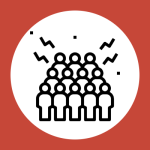Section 2 – Responsibilities and Resources in Research Partnerships
Ground rules: start out by building relationships
Subhanya Sivajothy; Melissa Cuthill; Neha Gupta; and Keshav Mukunda
This section will cover community protocols between community members and researchers as it pertains to research data management with particular attention to data governance. It is intended for individuals, community members and organizations who do not have familiarity with the research process as well as for researchers who want to engage in research with a community.
An individual or group cannot make an informed decision to participate without the proper familiarity of research and data governance; therefore, this section is intended to provide community members with questions that you can ask the researcher if you decide to participate in their research or to help you decide whether to participate, or to continue participating throughout the project. This tool can also be used if your community wants to approach researchers about initiating a project, although there may be a need to alter certain questions.

Stemming from previous institutional histories and events, community-researcher partnerships can be impacted by mistrust and can be further reified by researcher behaviours and communication styles. In “Trust as an ethical construct in community-based participatory research partnerships,” Lucero identifies critical reflective trust as “being at the place in a relationship where mistakes and other issues resulting from differences can be discussed and resolved.” It is a relational trust that develops over time through repeated encounters and interactions. The high level framing for this section’s questions and discussions to have for the before, during and after stages of a research project, with the understanding that the research process is iterative and research consent is an ongoing process of communication.
While the sections are structured as before, during and after (around the timeline of a research project), it is recommended that both community partners and researchers review the entire guide before embarking on their partnership. It is also good at this stage to plan for flexibility as you work through the toolkit as the research process may fall out of alignment or things may not go as planned. Working through these questions will help ensure that all parties have a shared understanding of the process, expectations, and potential challenges from the outset. By familiarizing themselves with the entire tool, partners can proactively address critical issues such as data ownership and access, expected benefits from research, ethical considerations, and communication strategies, setting a solid foundation for collaboration.
 Small Org: Along with using this tool, smaller organizations might want to work with the research team to balance community interest and needs with organizational capacity and resource limitations. With smaller organizations there is space for more collaborative decision making.
Small Org: Along with using this tool, smaller organizations might want to work with the research team to balance community interest and needs with organizational capacity and resource limitations. With smaller organizations there is space for more collaborative decision making.
 Large Org: This tool can be adapted to align with formal policies and procedures and can further build on this to provide training resources for staff. The decision making might have to be more structured in a larger organization, and there might need to be additional steps for maintaining institutional knowledge.
Large Org: This tool can be adapted to align with formal policies and procedures and can further build on this to provide training resources for staff. The decision making might have to be more structured in a larger organization, and there might need to be additional steps for maintaining institutional knowledge.
 No Org: If the community partner is an individual that is not affiliated with an organization the focus of this toolkit might be adapted toward understanding personal rights and agency within this partnership.
No Org: If the community partner is an individual that is not affiliated with an organization the focus of this toolkit might be adapted toward understanding personal rights and agency within this partnership.
Tool: community protocols for research and data governance
Before Research
This is the most important phase of a research partnership. Setting transparent parameters and having clear agreements between the research team and community partners helps to prevent misunderstandings and potential harms from extractive research. This is also a critical stage in which to discuss the importance of power dynamics to avoid dominance and foster a more participatory approach rooted in a co-creative approach and inclusive participation. The questions below are meant to be a guideline.
| Question | Additional Context | Response |
| Has the community partner been approached about a research project before or after a grant has already been submitted? | This allows community partners to be involved in the research design without having to fit a predetermined research agenda that has been decided solely by the researcher, which can lead to extractive research.
Follow up: Did the community partner have a say in what the study is about? Were they consulted about the methods used in the study? |
|
| How will the research relationship, as well as research data, be beneficial to both parties? | What are expected benefits from this research for you and your community?
Have you already discussed each group’s needs and priorities? |
|
| What is informed consent for you as a participant, community member, or community organization? | What are you agreeing to, for yourself as an individual and on behalf of the community? Is the consent ongoing throughout the collection process—can you withdraw and have your information removed at any time? | |
| What type of data literacy (the ability to read, understand and communicate data) will be required to engage with the research data and what type of data will this research project look at as well as produce? | This is important because the level of data literacy might affect the choice of research methods or might necessitate data training to effectively communicate findings. | |
| Does your community have representation, such as a governing body, which can be the point-of-contact or voice of the community to the researchers? Does the representation have legitimacy to represent the community? | A governing body can provide a more reliable and structured way to engage with the community as a whole rather than relying on individuals that can potentially be more biased.
These bodies can also advocate for community members and understand the dynamics of the community. |
|
| Is there a Data Management Plan (DMP)? Will the data be open? Where will the data be held and who will have decision rights over them? Who can process, analyze, share the data? When and under what circumstances? | If researchers or institutions alone have primary control of the data, this can worsen existing power imbalances. Furthermore, if they are the only group interpreting and disseminating the findings then there is a bigger risk of misrepresentation. | |
| Is the data collection framework or research design (categories, questions, forms of response) an appropriate way to gather information from your community? | The data collection framework should be relevant to the cultural norms and values of the group. They should also be relevant to the group’s needs and concerns. | |
| How will the community partner have access to the research findings? How will the community partner review and create subsequent reports or make decisions from the findings? | Discussing this will ensure that the research serves community interests and avoids extractive research practices. Community partners can also provide valuable feedback and context on the findings. | |
| What risks or harms to you or the broader community group could result from providing information to the researchers? | For example: researchers may misrepresent cultural practices or values that can lead to inaccurate or harmful conclusions; the research could perpetuate negative stereotypes or biases; the data collection process could cause emotional distress for participants. | |
| How will the work be shared between the groups? | For example, there can be cases of imbalance in the sense that researchers might dominate the intellectual components and assign ‘non-intellectual’ roles to community partners. |
How will you communicate?
Agreeing on preferred communication channels before beginning the research partnership will create a solid foundation for your research project. One team might prefer more frequent and informal communication, such as face-to-face meetings, phone calls, or community gatherings, and others may favor more formal communication methods, such as email, project management software, and scheduled meetings.
Discussing the best communication methods with your research team and partners establishes clear expectations, leading to a smoother workflow and reduced misunderstandings. Effective communication helps to create an environment where individuals feel comfortable and empowered to express their boundaries and preferences. By agreeing upon preferred communication channels, frequency of communication, and protocols, team members and partners can ensure accountability and enhance the overall efficiency and success of the research endeavour.
| Name and Role | How do they prefer to communicate | What is the expected response time? | |
| Who is the key contact of each group/partner? | |||
| Have you already discussed each partner’s needs and priorities? | |||
| How will decisions be made and communicated? | |||
| Are there built in check-in points/meeting between research team and community partners? Having fixed check-ins and progress updates will prevent communication channels from falling apart and ensure accountability. | |||
| How will dissenting viewpoints on the research in the community be addressed? This can be helped by having a diverse governance committee formed to guide the research and proactively create a code of conduct. | |||
| Are there language, cultural, or accessibility considerations that need to be addressed to ensure clear communication? | |||
| What are expectations around privacy regarding your conversations? | |||
| How will documentation of meeting minutes and agenda be managed? | |||
| Will communication methods and frequency change at different points of the research collaboration? |
During research
During this phase it is important to maintain regular check-ins as well as having open communication. This is also time to receive feedback from the community and adapt the research process as needed.
|
|
Additional Context | Response |
| Who is collecting data? Is the labour from community partner or staff appropriately valued and compensated? | Community members may be more likely to participate if the data is being collected by their own community members. This can lead to more participation and less biased research. However, this can also be incredibly disingenuous if the community partner isn’t a true collaborator on the research project, and if the research team isn’t sensitive to harm potentially posed by the research questions. | |
| What information will researchers collect? | Can participants be personally identified (age, gender, race, ethnicity, home/work address)? | |
| Is there a shared understanding around various levels of anonymity? | For example, the difference between anonymous, de-identified (removing identifying data) and anonymized (removing all links to an individual)? | |
| Is there a secure way to collect data: what tools and technologies are you using to collect my/our information and where will my/our information be stored? | Example: will information be collected on paper, digital recorder, and/or cell phone? Will the data be kept in a locked filing cabinet, on researcher’s work computer, on cloud etc.? All these choices will have different security implications. | |
| Has your research team discussed the risks of data linkages? | Combining data from diverse sources (for example other research studies, social media, news, publicly available information online) can pose ethical and privacy risks by increasing the likelihood of re-identifying individuals.
This can exacerbate existing biases particularly for smaller communities. This can be minimized by only collecting data that is necessary for the study and using proper anonymization techniques. |
|
| Are there/have there been opportunities here for community members or the research team to learn new skills or gain knowledge during this process? | Are there chances for community members and the research team to build capacity, and gain relevant skills that can empower them beyond the project? | |
| What are some challenges that you have encountered so far and how are you engaging in them? | This provides an opportunity for transparency and trust, as well as reflecting on obstacles. |
After research
After the research collection phase, it is important to ensure both collaborative and community-led interpretation of findings as well as choosing appropriate channels for presenting the work.
| Question | Additional Context | Response |
| How will the data be disseminated? | Technical and discipline specific language might be inaccessible to people outside of those academic disciplines. Choosing the correct format is important as it will affect whether the findings reach the intended audience: some people may prefer presentations, while others may prefer social media, or newsletters. Both researchers and community partners collaboratively interpreting and discussing the findings will allow for data to be understood in the most appropriate context. | |
| Looking at the data findings, what are ways that this data could be used for perpetuating harm? | When looking at the findings, what are ways that data could be misused to further marginalize communities? Is the data being framed in a way that blames individuals rather than addressing systemic causes? What context should be included? | |
| Have you discussed publishing data for re-use? Either by community partner or by researchers? | The Tri-Council Policy Statement: Ethical Conduct for Research Involving Humans 2 has updated information on broad consent vs. blanket consent. | |
| Have you discussed the differences between being a data owner and data steward? Owning the data vs. storing the data? | One function of a data steward is that they can connect the technical systems that hold the data with the users and creators of data. This can be useful if a group doesn’t have the technical capacity to store the data but still owns the data. Ownership in this sense means that they retain the right to control and make decisions about the data. | |
| Were power dynamics equitable, and how could the collaboration have been improved? | Was there balanced decision making and did everyone leave this project feeling respected? | |
| Is there interest in opportunities for collaboration in the future? | Was this partnership mutually beneficial? Did people leave the project with new skills, knowledge, and/or capacity? | |
| How will you ensure an honest assessment of the partnership’s strengths and weaknesses? | Reflection is important for replicating effective practices for future projects as well as learning from unsuccessful strategies. |
Access a fillable blank template you can use in your own work:
When an informed person or their legal caregiver agrees to be part of a research project. In Canada, consent has to be free (that nobody is pressuring you to participate), informed (that you have all the details needed to make a decision), and ongoing (you can’t just say yes once, you have to keep being ok with it). (Government of Canada, 2023)
Data ownership is the possession of and responsibility for the data collected or created over the course of a project. Maintaining ownership over your data will allow your community to continue making decisions about how it is used, including who it is shared with and for what purposes, and to utilize the data for the betterment of the community As data owners, you might also choose to assign responsibility for some care and maintenance activities to a data steward.
Data stewardship is the collection of day-to-day activities that ensure the long-term maintenance of the data. Data stewardship, and the activities people perform as data stewards, may be different from data ownership. For example, a community may own data that is stewarded by someone or something else (like an academic institution or academic researcher within an institution). That institution or researcher has the responsibility to ensure the data’s safety, security, and accessibility.

